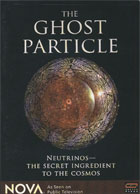
The Ghost Particle: Neutrinos: The Secret Ingredient of the Cosmos 2006
Distributed by WGBH Boston, 125 Western Avenue, Boston, MA 02134; 617-300-2000
Produced by DOX for NOVA/WGBH and BBC
Directed by David Sington
DVD, color, 56 min.
Jr. High - Adult
Physics
Date Entered: 05/26/2006
Reviewed by A. Ben Wagner, Arts and Sciences Libraries, University at Buffalo, State University of New YorkThis is an excellent overview of the 70-year attempt to detect and understand the neutrino, an elusive elementary particle since it has no charge and nearly no mass. This history is traced starting with the first theorization of the neutrino by Wolfgang Pauli in 1940, John Bahcall’s calculations of solar-generated neutrinos, and Ray Davis’ early detection experiments. The theoretical calculations and results from the early detectors were badly out of agreement with each other. This unresolved tension between the mathematical calculations and experimental results is a central focus, providing a certain suspense that is not resolved until the final segment. The last segment is a description of the recent Japanese and Canadian underground detectors that confirmed that neutrinos do have some tiny mass and can freely interchange between the three different types of neutrinos. Ray Davis and Masatoshi Koshiba received the 2002 Nobel Prize in Physics for the work described in this video.
Being a PBS NOVA science program, the production values are impeccable, including some beautiful ballroom dance sequences used to describe particle interactions. The DVD includes closed captions and a described video for the visually impaired. Quality education resources are available on the PBS http://www.pbs.org/wgbh/nova/neutrino/. web site including interviews, a timeline, teacher guide (also on the DVD), podcasts, and a complete transcript.
The Ghost Particle is an excellent case study in the scientific method, the collaborative nature of scientific progress, the patient, lengthy effort required, and the interplay between theory and experiments. One concern for teachers may be the 56-minute length of the documentary which would not fit into many classroom periods. A few parts are a bit slow-moving, perhaps due to the effort to maintain the suspense of unresolved issues.
The documentary is clearly targeted at general audiences. The science descriptions are clear, but simple and brief. This is not the resource for gaining significant background about neutrinos and elementary particle physics detectors. However, as a documentary that shows how science really develops over decades of work, it excels.